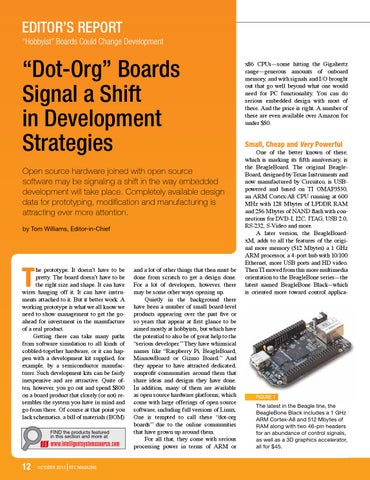EDITOR’S REPORT “Hobbyist” Boards Could Change Development
“Dot-Org” Boards Signal a Shift in Development Strategies Open source hardware joined with open source software may be signaling a shift in the way embedded development will take place. Completely available design data for prototyping, modification and manufacturing is attracting ever more attention. by Tom Williams, Editor-in-Chief
T
he prototype. It doesn’t have to be pretty. The board doesn’t have to be the right size and shape. It can have wires hanging off it. It can have instruments attached to it. But it better work. A working prototype is what we all know we need to show management to get the goahead for investment in the manufacture of a real product. Getting there can take many paths from software simulation to all kinds of cobbled-together hardware, or it can happen with a development kit supplied, for example, by a semiconductor manufacturer. Such development kits can be fairly inexpensive and are attractive. Quite often, however, you go out and spend $800 on a board product that closely (or not) resembles the system you have in mind and go from there. Of course at that point you lack schematics, a bill of materials (BOM) FIND the products featured in this section and more at
www.intelligentsystemssource.com
12
OCTOBER 2013 RTC MAGAZINE
and a lot of other things that then must be done from scratch to get a design done. For a lot of developers, however, there may be some other ways opening up. Quietly in the background there have been a number of small board-level products appearing over the past five or so years that appear at first glance to be aimed mostly at hobbyists, but which have the potential to also be of great help to the “serious developer.” They have whimsical names like “Raspberry Pi, BeagleBoard, MinnowBoard or Gizmo Board.” And they appear to have attracted dedicated, nonprofit communities around them that share ideas and designs they have done. In addition, many of them are available as open source hardware platforms, which come with large offerings of open source software, including full versions of Linux. One is tempted to call these “dot-org boards” due to the online communities that have grown up around them. For all that, they come with serious processing power in terms of ARM or
x86 CPUs—some hitting the Gigahertz range—generous amounts of onboard memory, and with signals and I/O brought out that go well beyond what one would need for PC functionality. You can do serious embedded design with most of these. And the price is right. A number of these are even available over Amazon for under $50.
Small, Cheap and Very Powerful
One of the better known of these, which is marking its fifth anniversary, is the BeagleBoard. The original BeagleBoard, designed by Texas Instruments and now manufactured by Circuitco, is USBpowered and based on TI OMAP3530, an ARM Cortex-A8 CPU running at 600 MHz with 128 Mbytes of LPDDR RAM and 256 Mbytes of NAND flash with connections for DVD-I, I2C, JTAG, USB 2.0, RS-232, S-Video and more. A later version, the BeagleBoardxM, adds to all the features of the original more memory (512 Mbytes) a 1 GHz ARM processor, a 4-port hub with 10/100 Ethernet, more USB ports and HD video. Then TI moved from this more multimedia orientation to the BeagleBone series—the latest named BeagleBone Black—which is oriented more toward control applica-
FIGURE 1 The latest in the Beagle line, the BeagleBone Black includes a 1 GHz ARM Cortex-A8 and 512 Mbytes of RAM along with two 46-pin headers for an abundance of control signals, as well as a 3D graphics accelerator, all for $45.
